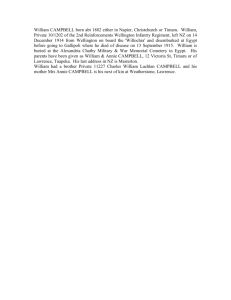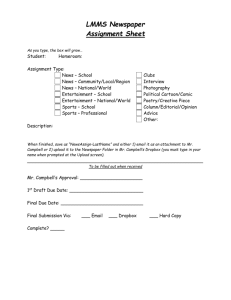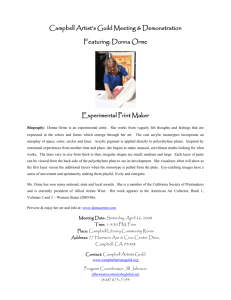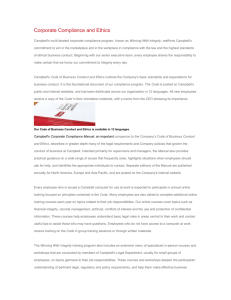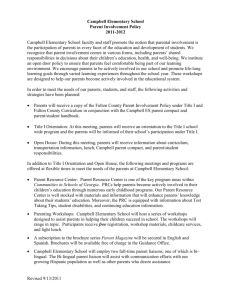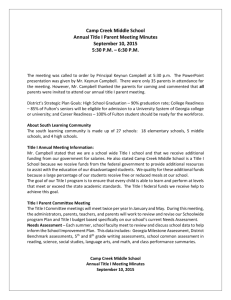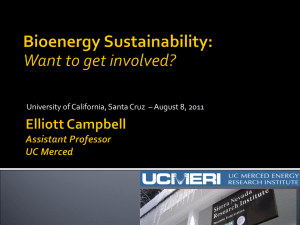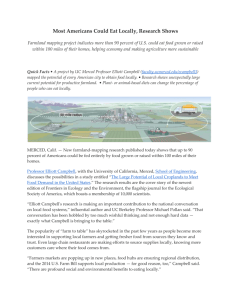PUBLICATIONS 83. Campbell, D.R. and J.M. Powers. 2015. Natural
advertisement
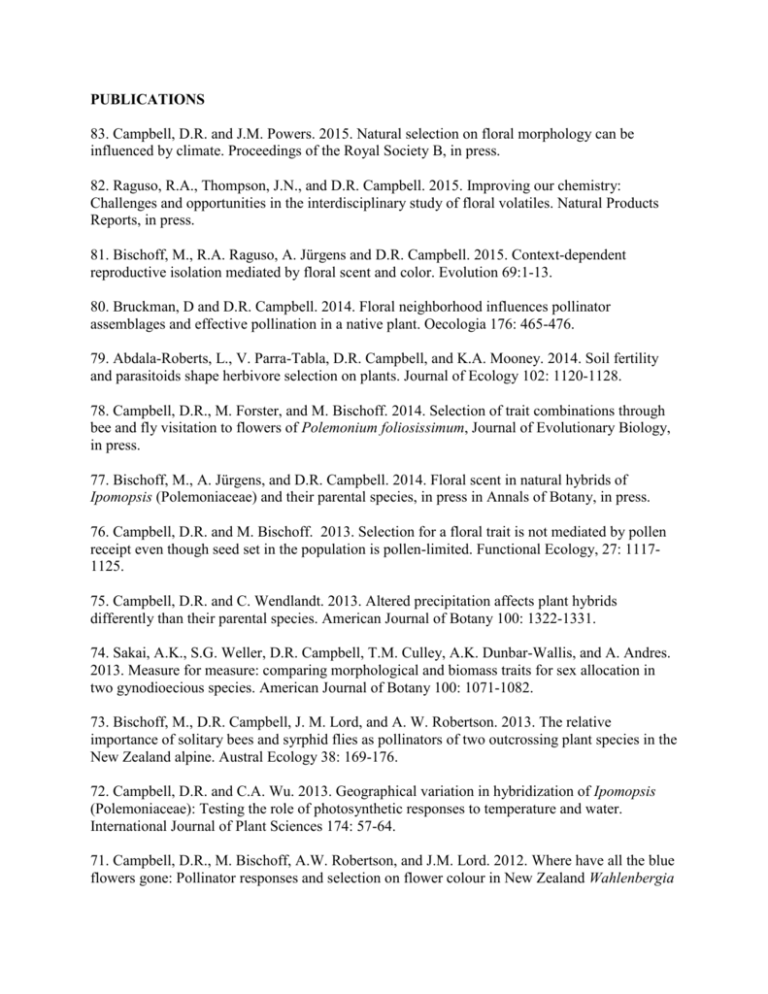
PUBLICATIONS 83. Campbell, D.R. and J.M. Powers. 2015. Natural selection on floral morphology can be influenced by climate. Proceedings of the Royal Society B, in press. 82. Raguso, R.A., Thompson, J.N., and D.R. Campbell. 2015. Improving our chemistry: Challenges and opportunities in the interdisciplinary study of floral volatiles. Natural Products Reports, in press. 81. Bischoff, M., R.A. Raguso, A. Jürgens and D.R. Campbell. 2015. Context-dependent reproductive isolation mediated by floral scent and color. Evolution 69:1-13. 80. Bruckman, D and D.R. Campbell. 2014. Floral neighborhood influences pollinator assemblages and effective pollination in a native plant. Oecologia 176: 465-476. 79. Abdala-Roberts, L., V. Parra-Tabla, D.R. Campbell, and K.A. Mooney. 2014. Soil fertility and parasitoids shape herbivore selection on plants. Journal of Ecology 102: 1120-1128. 78. Campbell, D.R., M. Forster, and M. Bischoff. 2014. Selection of trait combinations through bee and fly visitation to flowers of Polemonium foliosissimum, Journal of Evolutionary Biology, in press. 77. Bischoff, M., A. Jürgens, and D.R. Campbell. 2014. Floral scent in natural hybrids of Ipomopsis (Polemoniaceae) and their parental species, in press in Annals of Botany, in press. 76. Campbell, D.R. and M. Bischoff. 2013. Selection for a floral trait is not mediated by pollen receipt even though seed set in the population is pollen-limited. Functional Ecology, 27: 11171125. 75. Campbell, D.R. and C. Wendlandt. 2013. Altered precipitation affects plant hybrids differently than their parental species. American Journal of Botany 100: 1322-1331. 74. Sakai, A.K., S.G. Weller, D.R. Campbell, T.M. Culley, A.K. Dunbar-Wallis, and A. Andres. 2013. Measure for measure: comparing morphological and biomass traits for sex allocation in two gynodioecious species. American Journal of Botany 100: 1071-1082. 73. Bischoff, M., D.R. Campbell, J. M. Lord, and A. W. Robertson. 2013. The relative importance of solitary bees and syrphid flies as pollinators of two outcrossing plant species in the New Zealand alpine. Austral Ecology 38: 169-176. 72. Campbell, D.R. and C.A. Wu. 2013. Geographical variation in hybridization of Ipomopsis (Polemoniaceae): Testing the role of photosynthetic responses to temperature and water. International Journal of Plant Sciences 174: 57-64. 71. Campbell, D.R., M. Bischoff, A.W. Robertson, and J.M. Lord. 2012. Where have all the blue flowers gone: Pollinator responses and selection on flower colour in New Zealand Wahlenbergia albomarginata Journal of Evolutionary Biology 25: 352-364. 70. Pohl, N.B., J. Van Wyk and D.R. Campbell. 2011. Butterflies show flower colour preferences but not constancy in foraging at four plant species. Ecological Entomology 36: 290300. 69. Campbell, D.R., Weller, S.G., A.K. Sakai, T. M. Culley, P.N. Dang, and A.K. DunbarWallis. 2011. Genetic variation and covariation in floral allocation of two species of Schiedea with contrasting levels of sexual dimorphism. Evolution 65: 757-770. 68. Waser, N.M., Campbell, D. R., Price, M.V., and A.K. Brody. 2010. Density-dependent demographic responses of a semelparous plant to natural variation in seed rain. Oikos 119: 19291935. 67. Campbell, D.R., Wu, C.A. and S.E. Travers. 2010. Photosynthetic and growth responses of reciprocal hybrids to variation in water and nitrogen availability. American Journal of Botany 97: 925-933. 66. Campbell, D.R., M. Bischoff, J. Lord, and A.W. Robertson. 2010. Flower color influences insect visitation in alpine New Zealand. Ecology 91: 2638-2649. 65. Burd, M., T.L. Ashman, D.R. Campbell, M.R. Dudash, M.O. Johnston, T.M. Knight, S.J. Mazer, R.J. Mitchell, J.A. Steets, and J.C. Vamosi. 2009. Ovule number per flower in a world of unpredictable pollination. American Journal of Botany 96: 1159-1167. 64. Campbell, D.R. 2009. Using phenotypic manipulations to study multivariate selection of floral trait associations. Annals of Botany 103: 1557-1566. 63. Aldridge, G. and D.R. Campbell. 2009. Genetic and morphological patterns show variation in frequency of hybrids between Ipomopsis (Polemoniaceae) zones of sympatry. Heredity 102: 257265. 62. Kimball, S. and D.R. Campbell. 2009. Physiological differences between two species of Penstemon and their hybrids in field and common garden environments. New Phytologist 181: 478-488. 61. Kimball, S., D.R. Campbell, and C. Lessin. 2008. Differential performance of reciprocal hybrids in multiple environments. Journal of Ecology 96: 1306-1318. 60. Campbell, D.R., N.M. Waser, G. Aldridge, and C.A. Wu. 2008. Lifetime fitness in two generations of Ipomopsis hybrids. Evolution 62: 2616-2627. 59. Campbell, D.R. 2008. Pollinator shifts and the origin and loss of plant species. Annals of the Missouri Botanical Garden 95: 264-274. 58. Price, M.V., D.R. Campbell, N.M. Waser, and A.K. Brody. 2008. Bridging the generation gap in plants: pollination, parental fecundity, and offspring demography. Ecology 89: 15961604. 57. Sakai, A.K., S. G. Weller, T. M. Culley, D.R. Campbell, A.K. Dunbar-Wallis, A.K., and A. Andres. 2008. Sexual dimorphism and the genetic potential for evolution of sex allocation in the gynodioecious plant, Schiedea salicaria. Journal of Evolutionary Biology 21: 18-29. 56. Reithel, J.R. and D.R. Campbell. 2008. Effects of aggregation size and host plant on the survival of an ant-tended membracid (Hemiptera: Membracidae): Potential roles in selecting for generalized host plant use. Annals of the Entomological Society of America 101: 70-78. 55. Wu, C.A. and D.R. Campbell. 2007. Leaf physiology reflects environmental differences and cytoplasmic background in Ipomopsis (Polemoniaceae) hybrids. American Journal of Botany 94: 1804-1812. 54. Weller, S.G., Sakai, A.K., Culley, T.M., Campbell, D.R., Ngo, P, and A.K. Dunbar-Wallis. 2007. Sexually dimorphic inflorescence traits in a wind-pollinated species: heritabilities and genetic correlations in Schiedea adamantis (Caryophyllaceae). American Journal of Botany 94: 1716-1725. 53. Aldridge, G. and D.R. Campbell. 2007. Variation in pollinator preference between two Ipomopsis contact sites that differ in hybridization rate. Evolution 61: 99-110. 52. Campbell, D.R. and N.M. Waser. 2007. Evolutionary dynamics of an Ipomopsis hybrid zone: confronting models with lifetime fitness data. American Naturalist 169: 298-310. (Selected by Faculty of 1000). 51. Aldridge, G. and D.R. Campbell. 2006. Asymmetrical pollen success in Ipomopsis (Polemoniaceae) contact sites. American Journal of Botany 93: 903-909. 50. Campbell, D.R. and G. Aldridge. 2006. Floral biology in hybrid zones. In Harder L. and Barrett S (ed.) Ecology and Evolution of Flowers. Oxford University Press, Oxford. 49. Wu, C.A. and D. R. Campbell. 2006. Environmental stressors differentially affect leaf ecophysiological responses in two Ipomopsis species and their hybrids. Oecologia 148: 202212. 48. Culley, T.M., A.K. Dunbar-Wallis, A.K. Sakai. S.G. Weller, M. Mishio, D.R. Campbell, and M. Herzenach. 2006. Genetic variation of ecophysiological traits in two gynodioecious species of Schiedea (Caryophyllaceae). New Phytologist 169: 589-601. 47. Knight, T.M., J.A. Steets, J.C. Vamosi, S.J. Mazer, M. Burd, D.R. Campbell, M.R. Dudash, M.O. Johnston, R.J. Mitchell, and T.L. Ashman. 2005. Pollen limitation of plant reproduction: pattern and process. Annual Review of Ecology, Evolution and Systematics 36: 467-497. 46. Weller, S.G., A.K. Sakai, T.M. Culley, D.R. Campbell, and A.K. Dunbar-Wallis. 2005. Predicting the pathway to wind pollination: Heritabilities and genetic correlations of inflorescence traits associated with wind pollination in Schidea salicaria (Caryophyllaceae). Journal of Evolutionary Biology 19: 331-342. 45. Campbell, D.R., C.A. Wu, and C. Galen. 2005. Ecophysiology of first and second generation hybrids in a natural plant hybrid zone. Oecologia 144: 214-225. 44. Price, M.V., Waser, N.M., Irwin, R.E., Campbell, D.R., and A.K. Brody. 2005. Temporal and spatial variation in pollination of a montane herb: a seven-year study. Ecology 86: 21062116. 43. Wu, C.A. and D.R. Campbell. 2005. Cytoplasmic and nuclear markers reveal contrasting patterns of spatial genetic structure in a natural Ipomopsis hybrid zone. Molecular Ecology 14: 781-792. 42. Ashman, T., T.M. Knight, J. Steets, P. Amarasekare, M. Burd, D.R. Campbell, M.R. Dudash, M.O. Johnston, S.J. Mazer, R.J. Mitchell, M.T. Morgan, and W.G. Wilson. 2004. Pollen limitation of plant reproduction: Ecological and evolutionary causes and consequences. Ecology 85:2408-2421. 41. Campbell, D.R. 2004. Natural selection in Ipomopsis hybrid zones: implications for ecological speciation. New Phytologist 161: 83-90. 40. Campbell, D.R., Alarcon, R., and C.A. Wu. 2003. Reproductive isolation and hybrid pollen disadvantage in Ipomopsis. Journal of Evolutionary Biology 16: 536-540. 39. Waser, N.M. and D.R. Campbell. 2004. Adaptive speciation in flowering plants. In Dieckmann, U., Metz, H., Doebeli, M. and Tautz, D. (editors), Adaptive Speciation. Cambridge University Press, Cambridge, UK. 38. Campbell, D.R., M. Crawford, A.K. Brody, and T.A. Forbis. 2002. predispersal seed predation in a natural hybrid zone. Oecologia 131: 436-443. Resistance to 37. Campbell, D.R., N.M. Waser, and G.T. Pederson. 2002. Predicting patterns of mating and potential hybridization from pollinator behavior. American Naturalist 159: 438-450. 36. Campbell, D.R. and N.M. Waser. 2001. Genotype by environment interaction and the fitness of plant hybrids in the wild. Evolution 55:669-676. 35. Wolf, P. G., D. R. Campbell, N. M. Waser, S. D. Sipes, T. R. Toler, and J. K. Archibald. 2001. Tests of pre- and post-pollination barriers to hybridization between sympatric species of Ipomopsis (Polemoniaceae). American Journal of Botany 88: 213-219. 34. Campbell, D.R. 2000. Experimental tests of sex allocation theory in plants. Trends in Ecology and Evolution 15: 227-231. 33. Alarcón, R. and D. R. Campbell. 2000. Absence of conspecific pollen advantage in the dynamics of an Ipomopsis (Polemoniaceae) hybrid zone. American Journal of Botany 87: 819824. 32. Sork, V. L., J. Nason, D. R. Campbell, and J. F. Fernandez-M. 1999. Landscape approaches to historical and contemporary gene flow in plants. Trends in Ecology and Evolution 14: 219223. 31. Krupnick, G. A., A. E. Weis, and D. R. Campbell. 1999. The consequences of floral herbivory for pollinator service to Isomeris arborea. Ecology 80: 125-134. 30. Campbell, D. R., N. M. Waser, and P. G. Wolf. 1998. Pollen transfer by natural hybrids and parental species in an Ipomopsis hybrid zone. Evolution 52: 1602-1611. 29. Meléndez-Ackerman, E., and D. R. Campbell. 1998. Adaptive significance of flower color and inter-trait correlations in an Ipomopsis hybrid zone. Evolution 52: 1293-1303. 28. Campbell, D. R. 1998. Variation in lifetime male fitness in Ipomopsis aggregata: tests of sex allocation theory. American Naturalist 152: 338-353. 27. Campbell, D. R. 1998. Multiple paternity in fruits of Ipomopsis aggregata (Polemoniaceae). American Journal of Botany 85: 1022-1027. 26. Campbell, D. R. 1997. Genetic correlation between biomass allocation to male and female functions in a natural plant population. Heredity 79:606-614. 25. Meléndez-Ackerman, E., D. R. Campbell, and N. M. Waser. 1997. Hummingbird behavior and mechanisms of selection on flower color in Ipomopsis. Ecology 78: 2532-2541. 24. Campbell, D. R. 1997. Genetic and environmental variation in life-history traits of a monocarpic perennial: a decade-long field experiment. Evolution 51: 373-382. 23. Campbell, D. R., N. M. Waser, and E. J. Meléndez-Ackerman. 1997. Analyzing pollinatormediated selection in a plant hybrid zone: hummingbird visitation patterns on three spatial scales. American Naturalist 149: 295-315. 21. Campbell, D. R., N. M. Waser, and M. V. Price. 1996. Mechanisms of hummingbirdmediated selection for flower width in Ipomopsis aggregata. Ecology 77: 1463-1472. 20. Wolf, P. G. and D. R. Campbell. 1995. Hierarchical analysis of allozymic and morphometric variation in a montane herb, Ipomopsis aggregata (Polemoniaceae). Journal of Heredity 86: 386-394. 19. Campbell, D. R., N. M. Waser, and M. V. Price. 1994. Indirect selection of stigma position in Ipomopsis aggregata via a genetically correlated trait. Evolution 48: 55-68. 18. Campbell, D. R. and K. J. Halama. 1993. Resource and pollen limitations to lifetime seed production in a natural plant population. Ecology 74: 1043-1051. 17. Campbell, D. R. 1992. Variation in sex allocation and floral morphology in Ipomopsis aggregata (Polemoniaceae). American Journal of Botany 79: 516-521. 16. Weis, A. E. and D. R. Campbell. 1992. Plant genotype: a variable factor in insect-plant interactions. Pages 75-111 in M. D. Hunter, T. Ogushi and P. W. Price (eds.), Resource Distribution and Animal- Plant Interactions. Academic Press, San Diego. 15. Campbell, D.R. and J.D. Dooley. 1992. The spatial scale of genetic differentiation in a hummingbird-pollinated plant: comparison with models of isolation by distance. American Naturalist 139: 735-748. 14. Campbell, D.R. 1991. Comparing pollen dispersal and gene flow in a natural plant population. Evolution 45: 1965-1968. 13. Campbell, D.R., N.M. Waser, M.V. Price, E.A. Lynch, and R.J. Mitchell. 1991. Components of phenotypic selection: pollen export and flower corolla width in Ipomopsis aggregata. Evolution 45: 1458-1467. 12. Campbell, D.R. 1991. Effects of floral traits on sequential components of maternal fitness in Ipomopsis aggregata. American Naturalist 137: 713-737. 11. Campbell, D.R. and N.M. Waser. 1989. Variation in pollen flow within and among populations of Ipomopsis aggregata. Evolution 43: 1444-1455. 10. Campbell, D.R. 1989. Inflorescence size: test of the male function hypothesis. American Journal of Botany 76: 730-738. 9. Campbell, D.R. 1989. Measurements of selection in a hermaphroditic plant: variation in male and female pollination success. Evolution 43: 318-334. 8. Campbell, D.R. and N.M. Waser. 1987. The evolution of plant mating systems: multilocus simulations of pollen dispersal. American Naturalist 129: 593-609. 7. Campbell, D.R. 1987. Interpopulational variation in fruit set: the role of pollinationlimitation in the Olympic Mountains. American Journal of Botany 74: 269-273. 6. Campbell, D.R. 1986. Predicting plant reproductive success from models of competition for pollination. Oikos 47: 257-266. 5. Campbell, D.R. and A.F. Motten. 1985. The mechanism of competition for pollination between two forest herbs. Ecology 66: 554-563. 4. Campbell, D.R. 1985. Pollinator sharing and seed set of Stellaria pubera: competition for pollination. Ecology 66: 544-553. 3. Campbell, D.R. 1985. Pollen and gene dispersal: the influences of competition for pollination. Evolution 39 :418-431. 2. Campbell, D.R. 1983. Pollinator sharing and reproduction in a forest herb. PhD dissertation, Duke University, Durham NC. 1. Motten, A.F., D.R. Campbell, D.E. Alexander, and H.L. Miller. 1981. Pollination effectiveness of specialist and generalist visitors to a North Carolina population of Claytonia virginica. Ecology 62: 1278-1287.
